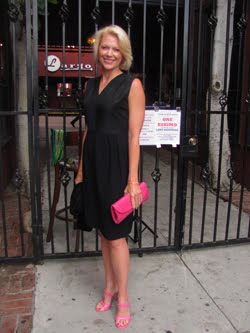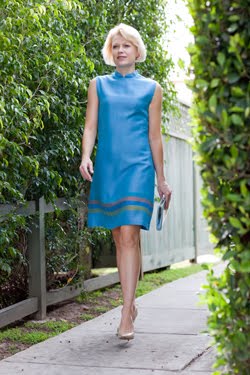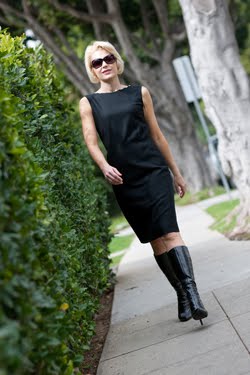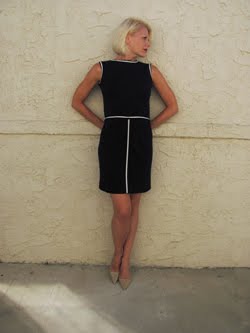The TCM Classic Film Festival is coming this April and I couldn't be more thrilled with this year's theme--Style in the Movies. Even more thrilling is that they have included spotlights on certain genres that I absolutely love, such as Art Deco (think Fred Astaire and Ginger Rogers) and film noir. The focus on film noir is why I have dedicated much of January to its movies, locations, and all around style. It's always been a powerful influence on me...whether it's the pre-noir Shanghai Express (1932) or the classic noir Gilda (1946) or the neo noir of Blade Runner (1982).
Something that Blade Runner and Chinatown (1974) both do especially well is use a multitude of incredible locations to create their neo noir landscapes. Between the two, they seem to include nearly every one of Los Angeles' historic landmarks. I visited one over the holidays--Union Station--deeply impressed by its mix of architectural styles and how it's been so well preserved while still being a functioning train station. As I stood there, I started longing to visit other iconic locations in LA. And so, my next trip would take me downtown to the corner of Broadway and 3rd Street--home of the Pan American Building, Million Dollar Theater, and (drumroll, please) the Bradbury Building.
I was most excited to experience the Bradbury, of course. After all, the place has been a fixture in noir over the years, seen in the likes of The Unfaithful (1947), Shockproof (1949), D.O.A. (1950), M (1951 version), Chinatown, and Blade Runner. It also allegedly appeared in Citizen Kane (1941). And it is widely thought--though not true--that the Bradbury appeared in Double Indemnity (1944) as well.
Opened in 1893, the Bradbury Building is one of the oldest buildings in downtown Los Angeles. Even so, its interior architecture was based on the future. Its design was inspired by the 1887 science fiction novel Looking Backward by Edward Bellamy. In it, the author described a utopian society in the year 2000 whose office buildings included a
...vast hall full of light, [which was] received not alone from the windows on all sides, but from the dome [ceiling], the point of which was a hundred feet above....The walls and ceiling were frescoed in mellow tints, calculated to soften without absorbing the light which flooded the interior.Architect George Wyman was inspired by these words, especially when creating the glass ceiling of the Bradbury that constantly floods the central courtyard with light. And the combination of glazed brick, polished wood, terracotta, Belgium marble stairs, and Mexican tile floors do indeed give the place a "mellow tint" and very warm feeling, one which is rarely communicated on film. Perhaps most impressive is the shiny black fillagree and cage elevators of wrought iron (rather than masonry) that contrast against it all.
With this kind of magic inside, you assume that will somehow manifest on the outside as well. Instead, the courtyard is hidden inside an exterior that is quietly beautiful with simple red brick and details of its Italian Renaissance Revival and Romanesque Revival architecture. So join me in experiencing the mystery of the Bradbury Building and its noir neighbors downtown at Broadway and 3rd.
The Bradbury very early in its history (above)
and later in the 1950s
The Bradbury Building today
Terracotta is one of the materials of the Bradbury both inside and out
Welcome to the Bradbury Building!
The first look inside the building with a glimpse at the courtyard
and a flight of marble stairs
Femme fatale: 1950s yellow silk shirtdress with belt, 1950s black leather box purse,
Guess black leather platform peeptoe pumps, black and gold bead earrings
The magnificent central courtyard of the Bradbury
Light always enters the courtyard due to the glass domed ceiling
One of the Bradbury's tenants is appropriately the Los Angeles District Attorney...
I couldn't help but imagine Phillip Marlowe on his way
The wrought iron caged elevators
Saying goodbye to the Bradbury and heading across to the Million Dollar Theater
Directly across the street from the Bradbury Building is the Million Dollar Theater. Opened in 1918, the then-named Grauman's Theater was one of the first movie palaces in the United States. Sid Grauman's star-studded opening night included the premiere of The Silent Man and giants Cecil B. de Mille, D. W. Griffith, Charlie Chaplin, Mary Pickford, Douglas Fairbanks, and Thomas Ince in attendance.
Quickly nicknamed the Million Dollar Theater (and renamed in 1922) due to its high costs, I started to understand why as I learned about and approached the building for the first time. For starters, multiple architects were involved. Albert C. Martin, Sr. was responsible for the tower, but it was sculptor Joseph Mora who decorated it in a variation of Spanish Rococo style called Churrigueresque. His ornamentation and molded features, including heroic figures of the arts, are found all over the theater's facade. This is carried through to the sides of the building as well with sculpture of unique symbols of Western Americana. And yet another architect, William Lee Woollett, was responsible for the equally impressive and ornate interior.
Sid Grauman sold the Million Dollar Theater in 1924 so he could concentrate on the construction that was happening in Hollywood. His Egyptian Theater had already opened in 1922, and his dream Chinese Theater would be ready for its premiere in 1927. Both would make him partially responsible for the entertainment center of Los Angeles shifting from downtown to Hollywood. As a result, the movies left the Million Dollar in the 1940s, and instead began seeing more musical acts like legends Billie Holliday, Nat King Cole, and Cab Calloway.
Just some of the incredible sculptural detail on the facade
Under the marquee and into the lobby
The theater then and now
The Americana sculpture on the side of the building includes longhorn "skulls"
Saying goodbye to the theater and hello to the Pan American
Last but not least, crossing 3rd Street on Broadway takes you to the Pan American Building. Not quite as well known as the other two or as elaborate in its architecture, but still impressive. After all, the 1895 structure also counts itself as one of the oldest in Los Angeles. And interestingly, it was even the home of the Mexican consulate during World War II. But most know it from Blade Runner, where it played the the disreputable Yukon Hotel. Audiences also saw Pris (Darryl Hannah) standing in front of it watching Deckard (Harrison Ford) walk into the Bradbury just across the street.
The Pan American now boasts beautiful modern lofts inside, which take advantage of its incredible innate structure and is an example of the movement to really renovate downtown. I love it...I've seen so much happen since starting my showroom at the California Market Center (a few blocks away from this visit) just last year. Though there are new buildings being built, more and more there is a deep respect for the past and repurposing historic locations rather than tearing them down. For me, that is as it should be and it was such a thrill for me to see these landmarks--the Bradbury, Million Dollar Theater, and Pan American--still so much a part of Los Angeles.
This downtown Broadway theater district in the 1940s (above)
and marble engraving at the corner of Broadway and 3rd Street



























































































































14 comments:
May I be the first to say, well done! This is a marvelous tour of these iconic buildings, and I love that your respect and admiration for the builders and the buildings comes across in every word. Some of the images made me gasp and I felt like I had been there so many times. I wonder how many other film fans like myself are encountering these images and saying "Oh, so THAT'S what that building is!" Such a lovely post, Kimberly. Congrats and wow!
Love, Kay
www.moviestarmakeover.com
Thank you Kay! As always, you are beyond kind with your comments and I really appreciate them. I'm so glad you enjoyed the journey...they are pretty awe-inspiring places, let me tell you. I'd love to go to an event at the Million Dollar Theater or at some of the other great historic theaters in town to see a retrospective. It's something I haven't done yet. Up and down Broadway there are tons of old theaters that have been turned into other businesses (and many, unfortunately, not so well), so I know it's important to support the ones that somehow still endure.
I hope that other film or history fans do stop by GlamAmor and enjoy these virtual tours. So often in my research, I am let down by the collections of images that are offered for these incredible locations. Thus, it's become a goal of mine to take my own photographs and let you look at and learn about these historic locations through my eyes. I really long to give them the attention they are due.
Thanks again!
These old buildings still look so great. The pictures are excellent and really show how beautiful they are and were. The history that you include, the old photos, and interior shots really make it a fun learning experience. Thanks for a great feature Kimberly.
I enjoy your out and about series very much. I lead historic walks and know how much research goes into their creation, which then must be translated into an interesting narrative. You do such a wonderful job--I've never been to LA (except via the movies and Perry Mason), but feel like I'm getting to know the city. I had no idea that Dekker's apartment was in a real building; is the Bradbury a residential building, or for offices? Looking forward to the next walk. Kattherine Louise
Thanks Kevin and Katherine Louise! The Out & About series is indeed a lot of work, but it truly is a labor of love. These are places that deserve to be appreciated and remembered, and I'm happy to be one of the stewards of this. I'm so glad that people are learning while being entertained...I really appreciate that.
In answer to your question, Kat Lou, the Bradbury is strictly an office building. And here are the BLADE RUNNER locations and what they are in historic LA:
Union Station--the inside of the BR police station
Bradbury Building--J.R. Sebastian's apartment building
Million Dollar Theater--in shot when Harrison Ford enters J.R. Sebastian's apartment building (Bradbury)
Pan American Building--replicant Leon's apartment building, where Harrison goes to investigate and finds photos and faux snake scale
Frank Lloyd Wright's Ennis House--Harrison's apartment exterior and interior (though he goes up an elevator in the movie as well)
The production designers do an incredible job of using real places but creating that BR environment around it. Really well done and such an homage to its film noir roots.
I just hope they didn't substitute fiberglass columns for those buildings; those structures look real awesome!
It is definitely an architectural marvel. The idea of having an indoor podium is ingenuity at its finest. To be able to come up with that kind of design, it is obvious that this is a product of many clever minds that worked together as one.
It's interesting that the Pan American isn't receiving the same amount of exposure as the other two buildings in this post. Judging from how you described the interiors and lofts, it has to be a top tourist attraction by now.
Well, Chrisitine, existing pictures as well as access simply aren't as available as the other two buildings. I wish I could have gotten inside to take my own, but it wasn't allowed. Had the same experience with the Eastern buidling in downtown LA. Most people don't really know about the Pan American, so it's not that big of a tourist attraction. But the Bradbury is and they still show things at the Million Dollar Theater as you can see on its marquee.
Thanks for dropping by!
This building should be protected and maintained. As for coming years, I can predict that this will be an official landmark.
I really love these types of buildings and structure. You get a feel like your going back through time. Thanks for sharing.
I must say that, the seem-to-be-spiral stairwell what awes me the most. It's like an infinity pathway, that could bring you somewhere very far from where you are.
I completely agree with you, Ellis. The Bradbury is one of the best and should be protected.
I agree with you, Tina. When you're there, you definitely feel like you've gone back in time. It's especially true for those of us who love film noir...it feels like you've entered a 1940s movie. :)
Post a Comment